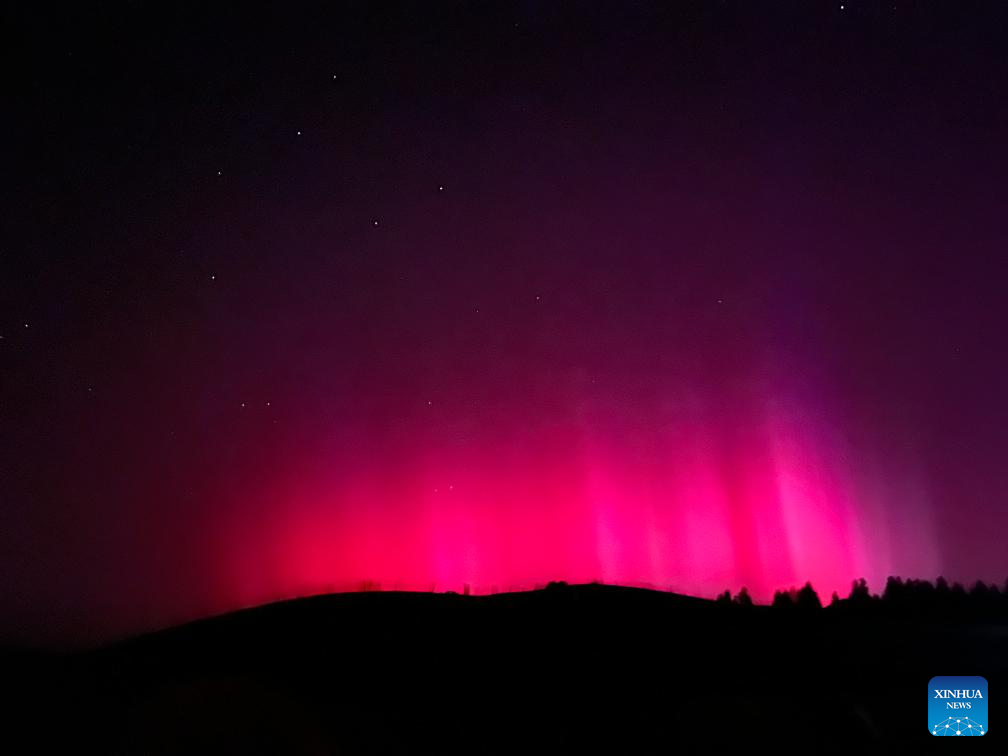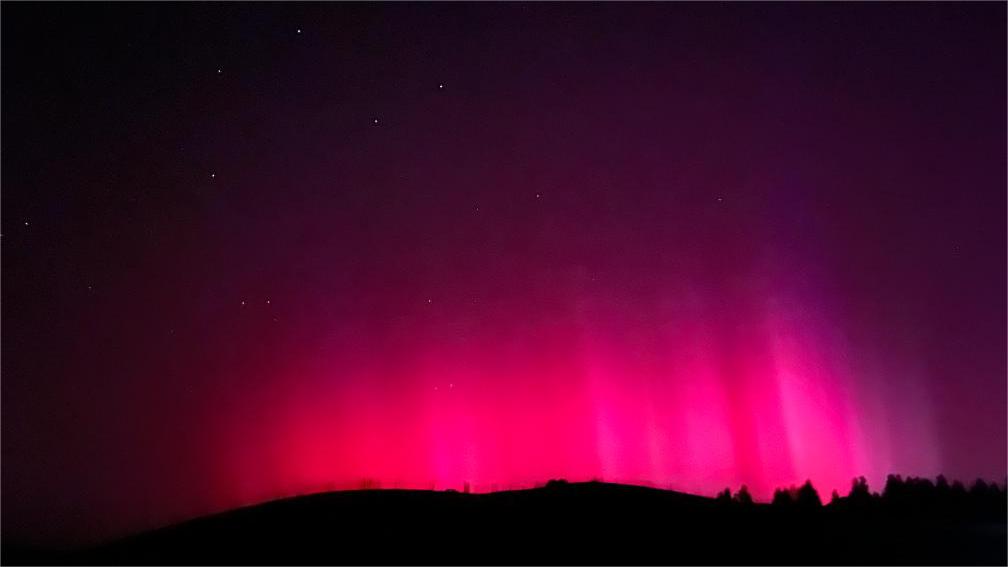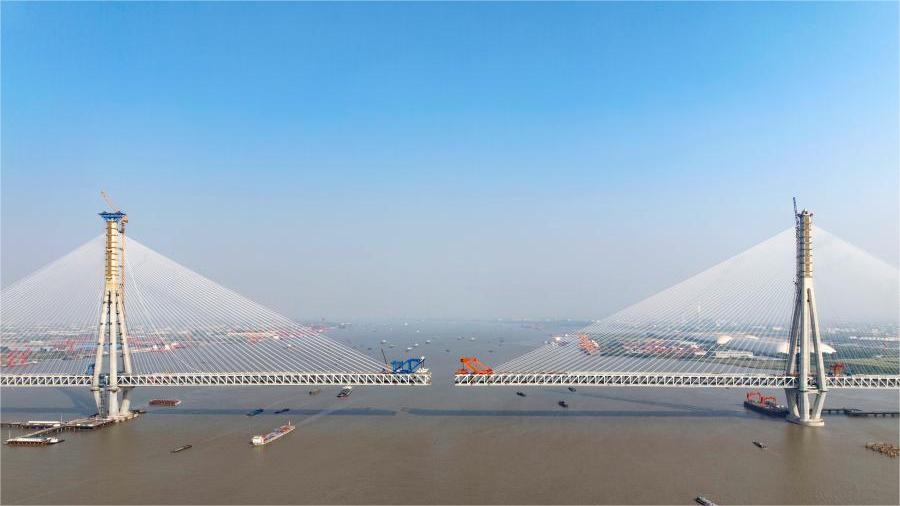Strongest geomagnetic storm in two decades erupts with limited impact on public

This photo taken with a mobile phone on May 11, 2024 shows the northern lights near Nanshan scenic spot in Urumqi, capital of northwest China's Xinjiang Uygur Autonomous Region. (Xinhua/Chen Shuo)
From Northwest China's Xinjiang Uygur Autonomous Region to Northeast China's Heilongjiang Province, multiple northern regions across China are among the best destinations to enjoy the stunning beauty of the aurora - a breathtaking gift brought by the strongest geomagnetic storm in two decades, which attracts visitors and photographers to rush for the mesmerizing display by the nature.
The Earth's magnetic field experienced a massive geomagnetic storm (kp=9) on the night of Friday to the early hours of Saturday, due to a coronal mass ejection event from the sun. At 9:32 am on Saturday, the National Space Weather Monitoring and Early Warning Center under the China Meteorological Administration issued a red alert for geomagnetic storms, predicting moderate to high solar activity levels in the next three days, with the possibility of M-class or even X-class flares, leading to small to large geomagnetic storms, and even severe geomagnetic storms.
Regions such as Altay in Xinjiang, Mohe in Heilongjiang, and North China's Inner Mongolia Autonomous Region were hotspots for tourists and photography enthusiasts eager to witness this natural wonder.
The night sky in Altay, located in northern Xinjiang, was adorned with colorful auroras, creating a mesmerizing spectacle for people who gazed upon it.
As a response, Altay decided to temporarily adjust the nighttime lighting of all its buildings to allow residents and tourists to better enjoy the aurora nightscapes. The adjustment period was from midnight on Saturday until the early morning of Sunday.
Local tourism departments and businesses tailored services for tourists interested in viewing the auroras at night. Discounts were offered at various observation lodges in Altay, such as multiple inns, to provide affordable and convenient accommodations for visitors.
The unique geographical location and climatic conditions of Xinjiang play a significant role in the formation of vibrant auroras during geomagnetic storms. Xinjiang's dry climate, high atmospheric transparency and special magnetic field distribution create favorable conditions for the interaction of charged particles with atmospheric molecules and atoms, resulting in more pronounced light phenomena, according to experts.
Interestingly, the phenomenon of the northern lights even extended as far as Beijing on Saturday. A student from a Beijing-based university told the Global Times on Sunday that he embarked on a six-hour journey to the mountains of Miyun district on the night of Saturday to capture a dazzling aurora display. This was his first time witnessing the auroras, and he was amazed to experience such a natural wonder at a latitude of 40 degrees north.
Another photography enthusiast surnamed Xing traveled 2,300 kilometers to Hulunbuir, Inner Mongolia and finally captured a spectacular aurora eruption. He described the sight of the auroras dancing in the sky as both mesmerizing and unattainable, expressing that no photograph could fully capture the awe-inspiring moment.
The ongoing solar storms are expected to continue to be active in the next two days, allowing for the possibility of widespread auroras in the northern hemisphere.
With the increase in solar activities since the beginning of the 25th solar activity cycle in 2019, events such as solar flares, solar proton events, and geomagnetic storms have become more frequent and intense especially since 2023, attracting public attention.
Many netizens jokingly blamed their insomnia, bad luck, and nightmares on the geomagnetic storm, claiming it was the cause of all their misfortunes.
While some concerns have been raised about the potential health effects of geomagnetic storms, current research indicates that they have minimal impact on human health. Claims of insomnia, drowsiness, palpitations, and restlessness due to geomagnetic storms are unfounded and should not be taken seriously.
However, according to the National Space Science Center of Chinese Academy of Sciences, geomagnetic storms and a series of space environmental events will have a serious impact on the earth.
For example, geomagnetic storms can damage satellites, power grids and power facilities, and even oil pipelines. The higher density of the upper atmosphere increases the resistance of satellite operation, thus speeding up the attenuation of satellite orbit. Hot plasma injection can cause surface charging of satellite, and high energy electron bursts can cause deep charging harm to satellite. Ionospheric storms could affect things like short-wave communications and satellite navigation.
As the sun continues to be active, the frequency and intensity of geomagnetic storms are expected to remain elevated, captivating the public with the beauty and wonder of celestial displays, experts said.
Photos
Related Stories
- View of northern lights in Urumqi
- Xinjiang's Kuqa ramps up efforts to preserve, utilize historical resources
- International youth discover the Xinjiang surprise
- Chinese premier urges Xinjiang to boost people's wellbeing, high-quality development
- Digital technologies facilitate wildlife conservation in NW China's Xinjiang
- Xinjiang tourism revenue up nearly 34 pct during May Day holiday
Copyright © 2024 People's Daily Online. All Rights Reserved.









